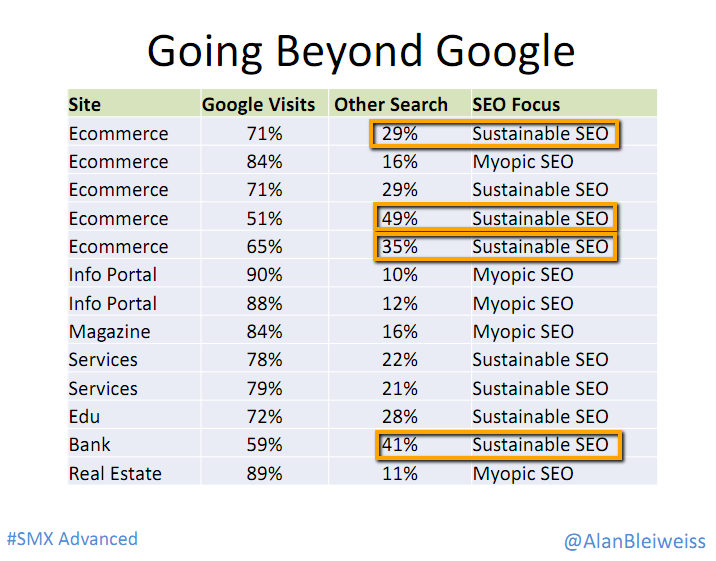At last week's SMX Advanced conference, SEO in the aftermath of Google's Panda update was one of the leading discussion topics. In Part 1 of this blog series, we looked at two tips experts offered on how marketers can break down their faulty notions of SEO (and their Panda-prone sites).
This second article looks at ways to build a Panda-friendly (and user-friendly) site to increase your chances of SEO success.
3. Build up good content.
In case this isn't obvious enough, providing good content is a leading way to survive in Google – or any other search engine. (We wrote an article on Bing's Duane Forrester stating that content is still king, and one from Matt Cutts on content marketing.)
During SMX Advanced's Q&A session with Matt Cutts, he indicated that marketers need to start thinking about how they can be creative with content. He emphasized that focusing on the original value of site copy and content is key.
“If you're rehashing content or writing low quality content, that's not good for the internet,” he said.
Similarly, during a link building panel, Roger Montti, owner of Martini Buster, advised that marketers not only offer valuable content, but also go a step further by working with writers who are industry authorities. Montti was discussing how marketers might position themselves as appealing guest bloggers to gain site links, but the same approach can be applied to writing for your own sites: Work with credible writers. 
Once you're working with credible writers (whether in-house experts or hired industry writers), offer author bios and accomplishments so that site visitors know they can trust they information on your pages. This step also ensures brands can fulfill the check list Google offered marketers looking to boost their SEO – “Is this article written by an expert or enthusiast who knows the topic well, or is it more shallow in nature?” (Plus, Google’s new authorship markup makes clear that the search giant is paying attention to author credibility…)
4. Pay attention to interaction metrics.
Mark Munroe from MerchantCircle theorized that Panda is a behavioral update. This seems to fit nicely with the other SEO tips all aimed at improving user experience. (If you add quality to the SERP with relevant information, provde good content, etc., you'll be more likely to catch clicks from users who really engage your pages.)
With this theory in mind, marketers will want to pay attention to any and all metrics they have that indicate user engagement as it might relate to ranking. Remember Brafton's news article about how one SEO found his email interaction levels impacted his SEO? We're talking all levels of interaction. 
Marketers can monitor bounce rates for specific pages. Bounces indicate that the user didn't get what he or she wanted off of a page and went to look elsewhere. This will not only tell you where you need to beef up your content for user experience, but it might also offer insight on pages that are acting as red flags for Google. (Munroe also pointed out that marketers will want to carefully look at the content behind “read more” buttons because these types of secondary pages are often susceptible to bounces.)
5. Go for sustainable (and social) link love.
Link building is now – as always – core to SEO, said SMX Advanced experts, but the methods used for gaining links are more important now than ever. During an SMX Advanced link building session, Brafton reported that experts agreed the ultimate way to gain links is to create quality content that other institutions and social users will want to share.
SMX Advanced panelists suggested that social signals, including links shared via social channels, will not necessarily become more important in terms of SEO rankings (though Brafton has reported that Matt Cutts says links from tweets can help Google index pages faster and appropriately rank the original sources over scrapers or secondary reports). One of the main reasons they believed shared links across users' social profiles may be important for SEO is because of how this could impact searchers' click behavior.
Search Engine Land's Vanessa Fox (formerly of Google) predicts that the search giant will develop more social signals on results pages. (And Google's recent push for people to create their Google profiles seems to support her theory). Similarly, Todd Friesen, director of SEO for Performics, points out that social links may not wield the power to move a page up to the No.1 result spot, but if there is a visual icon of a friend who shared a link to the sixth result, people may be more inclined to click the lower-ranking result advocated by a friend.
Also, Munroe pointed out that you should be linking to valuable resources. There's always the chance you'll spread good link karma and maybe receive reciprocal links to your own valuable content pages. More importantly, he suggests this could reduce bounce rates. If, indeed, behavior is key to the Panda update, you should send site visitors who aren't satisfied with what they found on your site to valuable resources instead of back to search results.
 Ultimately, the experts agreed that sites that want to rank well in Panda need to stop chasing the algorithm and start focusing on creating valuable user experiences. Perhaps this will be key to search survival because it might both boost Google rankings and help marketers achieve visibility in other search spaces. In fact, Alan Bleiweiss, Forensic SEO Consultant, reports that search marketers practicing sustainable SEO are receiving high volumes of traffic from other search sources.
Ultimately, the experts agreed that sites that want to rank well in Panda need to stop chasing the algorithm and start focusing on creating valuable user experiences. Perhaps this will be key to search survival because it might both boost Google rankings and help marketers achieve visibility in other search spaces. In fact, Alan Bleiweiss, Forensic SEO Consultant, reports that search marketers practicing sustainable SEO are receiving high volumes of traffic from other search sources.
Practice good SEO, achieve Google rankings and reduce dependence on Google.

